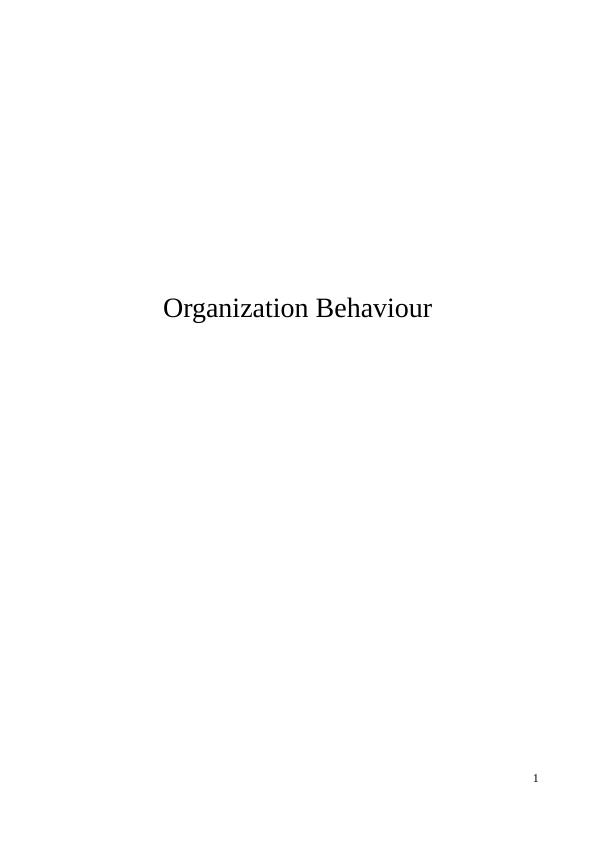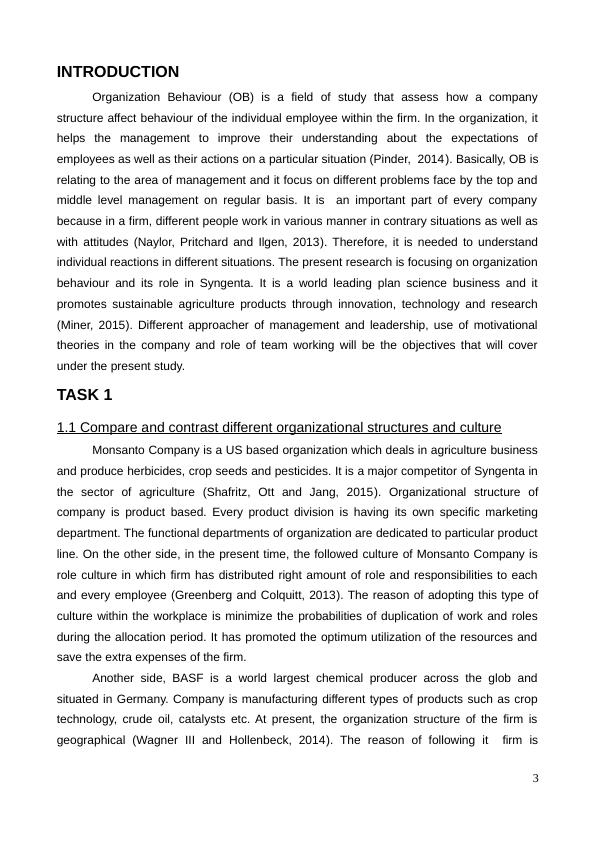Analysing the Organisational Behavior of Syngenta
Added on 2020-01-21
16 Pages5495 Words84 Views
Organization Behaviour 1

Table of ContentsINTRODUCTION ...............................................................................................................................3TASK 1.................................................................................................................................................31.1 Compare and contrast different organizational structures and culture......................................31.2 Impact of relationship between organization structure and culture on performance of Syngenta ..........................................................................................................................................41.3 Factors that influence individual behaviour at work.................................................................5TASK 2 ................................................................................................................................................52.1 Effectiveness of different leadership style ................................................................................52.2 Role of organizational theories in practice of management at Syngenta...................................62.3 Different approaches to management used by Syngenta and its competitor.............................7TASK 3 ................................................................................................................................................83.1 Impact of different leadership styles on motivation in Syngenta during the period of change.83.2 Compare between motivational theories and their application in Syngenta..............................93.3 Evaluate usefulness of motivation theory in Syngenta............................................................10TASK 4...............................................................................................................................................104.1 Explain the nature of groups and group behaviour within Syngenta.......................................104.2 Factors that promote or inhibit the development of effective teamwork at Syngenta ............114.3 Evaluate the impact of technology in Syngenta ......................................................................12CONCLUSION..................................................................................................................................13REFERENCES...................................................................................................................................142

INTRODUCTION Organization Behaviour (OB) is a field of study that assess how a companystructure affect behaviour of the individual employee within the firm. In the organization, ithelps the management to improve their understanding about the expectations ofemployees as well as their actions on a particular situation (Pinder, 2014). Basically, OB isrelating to the area of management and it focus on different problems face by the top andmiddle level management on regular basis. It is an important part of every companybecause in a firm, different people work in various manner in contrary situations as well aswith attitudes (Naylor, Pritchard and Ilgen, 2013). Therefore, it is needed to understandindividual reactions in different situations. The present research is focusing on organizationbehaviour and its role in Syngenta. It is a world leading plan science business and itpromotes sustainable agriculture products through innovation, technology and research(Miner, 2015). Different approacher of management and leadership, use of motivationaltheories in the company and role of team working will be the objectives that will coverunder the present study. TASK 11.1 Compare and contrast different organizational structures and cultureMonsanto Company is a US based organization which deals in agriculture businessand produce herbicides, crop seeds and pesticides. It is a major competitor of Syngenta inthe sector of agriculture (Shafritz, Ott and Jang, 2015). Organizational structure ofcompany is product based. Every product division is having its own specific marketingdepartment. The functional departments of organization are dedicated to particular productline. On the other side, in the present time, the followed culture of Monsanto Company isrole culture in which firm has distributed right amount of role and responsibilities to eachand every employee (Greenberg and Colquitt, 2013). The reason of adopting this type ofculture within the workplace is minimize the probabilities of duplication of work and rolesduring the allocation period. It has promoted the optimum utilization of the resources andsave the extra expenses of the firm. Another side, BASF is a world largest chemical producer across the glob andsituated in Germany. Company is manufacturing different types of products such as croptechnology, crude oil, catalysts etc. At present, the organization structure of the firm isgeographical (Wagner III and Hollenbeck, 2014). The reason of following it firm is3

operating its different branches at various locations. Every office has separate departmentand it has responsible for that region. Beside this, BASF has followed power culturebecause it has hard for the organization to take all the decisions of various branches by asingle person (DuBrin, 2013). It has assisted the management team of geographicallybased office in taking decision by small consult. CompanyOrganizational structure Culture MonsantoProduct basedRole culture BASFGeographically basedPower cultureOn the basis of the above discussion, Syngenta has to adopt its competitorsorganizational structure and type of culture for taking the advantage of high level ofcompetition. It helps in increase the market share in the comparative of its rivals. 1.2 Impact of relationship between organization structure and culture on performance of Syngenta Line of authority is an most essential element for the success of an organization.Both organizational structure and culture has put the combined impact on performance ofSyngenta (Scott and Davis, 2015). At present time, the current organizational structure ismatrix and culture is role. With the help of structure of company, the management haseasily defined the position of the different employees at the workplace. Similarly, the roleculture has developed the new opportunities for the staff members to achieve the successand growth. The combine impact of both organizational culture and structure on Syngentais it has reduced the communication gap situation between the workers at different level(Mowday, Porter and Steers, 2013). In addition to this, it has improved the productivity ofthe firm by promoting the creativity and innovation. The result of this is the quality ofagriculture goods are increasing. Rather than this, the impact of both existing organizational culture and structure onSyngenta is it has improved decision making process as well as performance level of thecompany (Robbins, Judge Millett and Boyle, 2013). Along with this, organization has setsome process to doing the work so that chances of mistakes or errors can be reduced. Inaddition to this, the present organizational structure and culture of Syngenta hasdeveloped a positive environment at the workplace which promoted team working betweenthe employee's (Haslam and et.al., 2014). Firm has effectively allocated the resources andoptimum utilized its resources and that reduce its expenses. 4

End of preview
Want to access all the pages? Upload your documents or become a member.
Related Documents
Organizational Structures and Culture of Syngentalg...
|13
|4459
|256
Organizational Behaviour at Syngenta - Reportlg...
|21
|7589
|263
Comparing and Contrasting Organizational Structures and Culturelg...
|16
|5270
|93
Organizational Behaviors Assignmentlg...
|12
|3923
|190
6436 oblg...
|8
|285
|334
Study on Organisation Behaviour (OB)lg...
|12
|4396
|52
